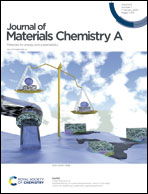Enhanced Na+ pseudocapacitance in a P, S co-doped carbon anode arising from the surface modification by sulfur and phosphorus with C–S–P coupling†
Abstract
Enhanced phosphorus (7.2 wt%) and sulfur (15.7 wt%) co-doped carbon (PSC) is synthesized via a one-step sintering of carbon disulfide and red phosphorus in a vacuum. It is found that S atoms can act as immobilization sites for phosphorus by covalently bonding with P atoms in the form of C–S–P, and thus high-level doping of phosphorus can be realized. Owing to the high-level doping, this co-doped carbon shows enlarged interlayer spacing, improved charge transfer capability and strong adsorption of Na+ ions. When tested as an anode for sodium ion batteries, this PSC delivers a high reversible capacity of 513.8 mA h g−1 at 100 mA g−1, excellent rate capability of 181.8 mA h g−1 at 10 A g−1 and superior cycling stability with a capacity of 290.1 mA h g−1 after 1000 cycles at 1 A g−1.



 Please wait while we load your content...
Please wait while we load your content...